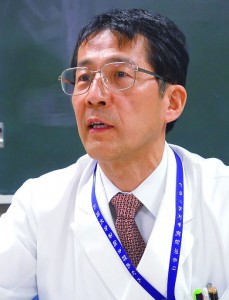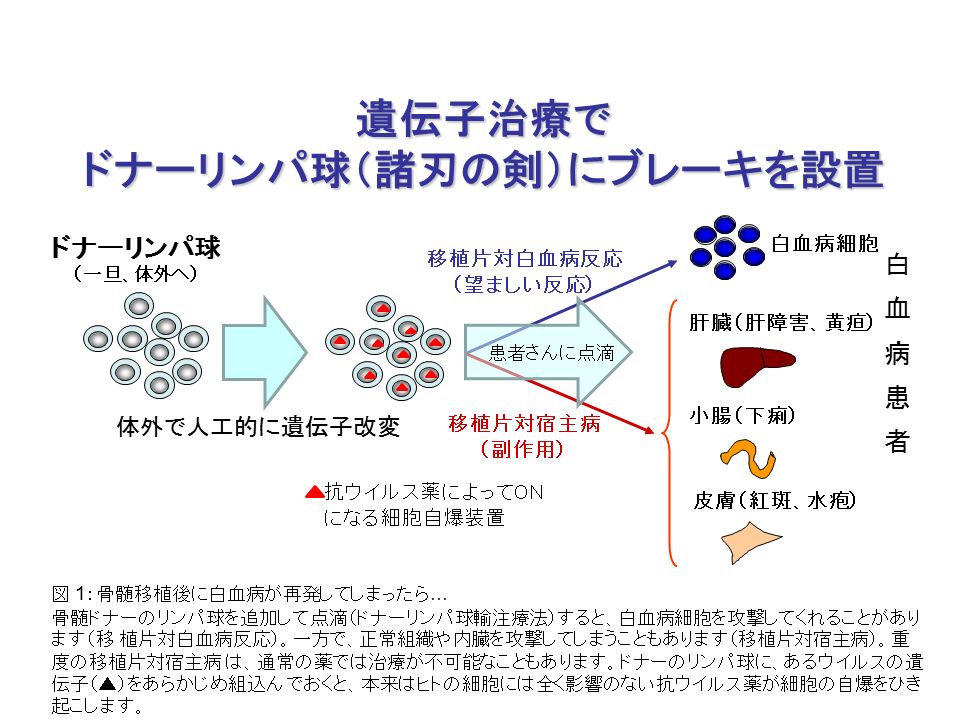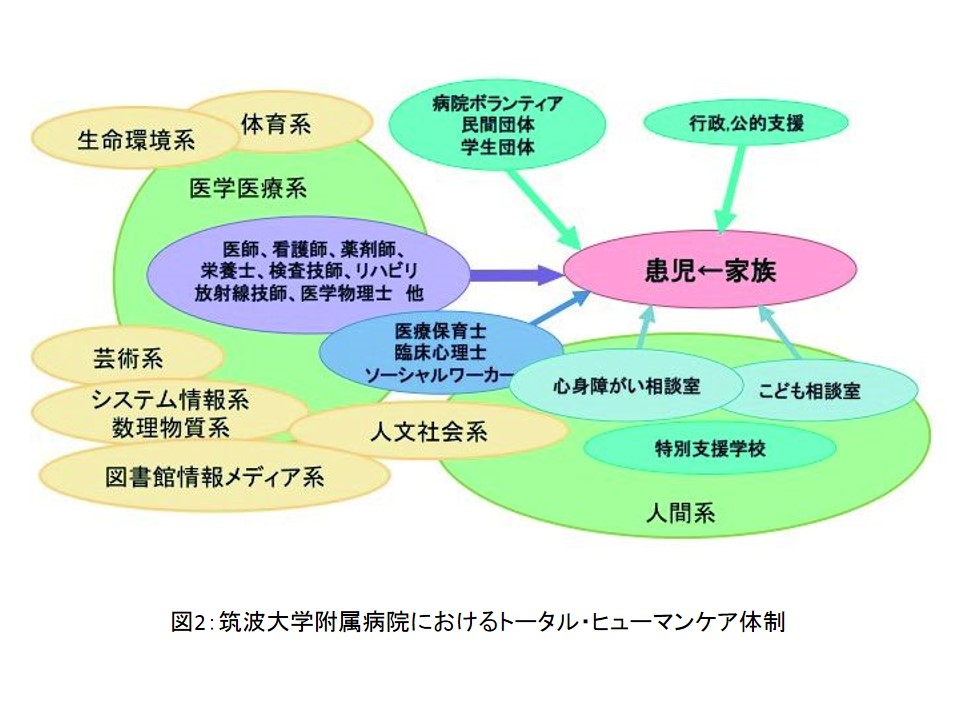他のメンバー : 瓜田 泰久 原 尚人 古谷 佳由理 庄司 一子 新開 統子 水本 斉志 増本 幸二 増本 智彦 大戸 達之 長谷川 雄一 田宮 菜奈子 藤代 準 野口 雅之 野口 惠美子 櫻井 英幸
キーワード:小児難病、トータル・ヒューマンケア、育児支援、弱者を作らない社会
http://www.md.tsukuba.ac.jp/clinical-med/pediatrics/index.html
http://www.pmrc.tsukuba.ac.jp/
 小児難病のうち小児がんは、かつては治癒が困難でしたが、医学のめざましい進歩によって、今では7割以上が治るようになりました。しかし、がんを治療中・治療後のこどもたちがその後の長い人生を幸せに送るためには、社会にとけこめるようにサポートすることが必要です。本リサーチユニットでは、小児がんに対する副作用の少ない治療法の確立とともに、治療中・治療後のこどもたちをサポートする医療職や保育士、心理士、ソーシャル・ワーカーなどの人材育成、治療中・治療後のこどもたちが社会参加できるバリアフリー共生社会づくりに取り組んでいます。
小児難病のうち小児がんは、かつては治癒が困難でしたが、医学のめざましい進歩によって、今では7割以上が治るようになりました。しかし、がんを治療中・治療後のこどもたちがその後の長い人生を幸せに送るためには、社会にとけこめるようにサポートすることが必要です。本リサーチユニットでは、小児がんに対する副作用の少ない治療法の確立とともに、治療中・治療後のこどもたちをサポートする医療職や保育士、心理士、ソーシャル・ワーカーなどの人材育成、治療中・治療後のこどもたちが社会参加できるバリアフリー共生社会づくりに取り組んでいます。
こどもたちにやさしい治療を届ける
私たちは、小児がんと闘うこどもたちにやさしい治療を届けることを目指して、様々な科と協力しながら研究をすすめています。たとえば、先進医療として提供中の陽子線治療法(放射線治療法のひとつ)は、従来のX線治療法に比べて副作用を最小限に抑えることができるため、全国から希望者を受入れています。また、筑波大学は日本で初めて小児の再発白血病に対する遺伝子治療を行なった実績を持っています(図1)。現在は、他の病気に対する新たな遺伝子治療法を開発中です。

こどもたちをとりまく人材を育成し、幸せな人生を送るための社会をつくる
私たちは、難病のこどもたちが治療中や治療後、社会にとけこめるようにサポートすることも重要であると考えています。そのために、学校の先生とも連携しながら、こどもたちの復学と健やかな成長の促進に取り組んでいます。同時に、医師だけでなく、こどもたちをサポートするための様々な専門職種(医療保育士など)の人材育成も行なっています(図2)。周辺医療機関・行政(保健、福祉、学校等)との緊密な連携システムを構築し、社会資源を有効活用する1つのモデ ルとして全国に提案しています。そこで育った若手は全国で活躍しています。
私たちはこどもたちの病気を治すだけでなく、成長の過程で抱える様々な問題を一緒に解決していきたいと思っています。そして、こどもたちが社会にとけこみ、幸せに生きられる社会づくりを目指しています。

社会への貢献・実績
● 我が国において小児死亡原因の上位を占める小児がんの救命率向上
● 副作用・治療毒性軽減と教育による、小児がん克服者の社会参加促進
● 受入側の要因分析と教育・意識改革・啓発による環境の調整
● 小児難病児・難病克服後の病弱児・障がい児本人の主体的参加を伴う多職種共同作業による高度バリアフリー・共生社会を実現し、人的絆による高齢化・介護社会に対応するためのモデルを提示
● 社会的弱者を作らない社会を提案
(取材:平成25年10月18日)
Construction of a barrier-free symbiotic society model through treating children with intractable diseases and promoting their health
Unit members : Urita, Yasuhisa Hara, Hisato Furuya Kayuri Shoji, Ichiko Shinkai Toko Mizumoto Masashi Masumoto Kouji Masumoto, Tomohiko Ohto, Tatsuyuki Hasegawa, Yuichi Tamiya, Nanako 藤代 準 Noguchi, Masayuki Noguchi, Emiko Sakurai, Hideyuki
Key words: pediatric intractable disease, total human care, childcare support, society that does not generate disadvantaged people
http://www.pmrc.tsukuba.ac.jp/en/index.html
Among pediatric intractable diseases, it was previously difficult to cure pediatric cancer, but more than 70% of children with cancer are now treatable owing to the marked advancements of medicine. However, in order for children undergoing treatment for cancer or those who have received such treatment to achieve sufficient well-being in their lives, it is necessary to aid them in adapting to society. Our research unit aims to establish treatment strategies for pediatric cancer patients that involve fewer side effects, train human resources to become professionals (e.g., healthcare providers, nursery teachers, psychologists, and social workers) who support children undergoing treatment for cancer or those who have received such treatment, and create a barrier-free symbiotic society where such children can thrive.
achieve sufficient well-being in their lives, it is necessary to aid them in adapting to society. Our research unit aims to establish treatment strategies for pediatric cancer patients that involve fewer side effects, train human resources to become professionals (e.g., healthcare providers, nursery teachers, psychologists, and social workers) who support children undergoing treatment for cancer or those who have received such treatment, and create a barrier-free symbiotic society where such children can thrive.
Provision of treatment associated with fewer side effects for children
To provide children with cancer with treatment associated with fewer side effects, we are conducting research in cooperation with various departments. For example, proton therapy that is currently available in our university as one of the advanced radiotherapies involves markedly fewer side effects compared to typical X-ray therapy, and so we can accept children who desire to receive this therapy from throughout Japan. In addition, the University of Tsukuba was the first to perform gene therapy for recurrent pediatric leukemia patients in Japan (Figure 1). We are currently developing novel gene therapy for other types of disease.
![Figure 1: If leukemia recurs after bone marrow transplantation When lymphocytes derived from the bone marrow donor are additionally injected (donor lymphocyte infusion therapy), they are likely to attack leukemia cells (graft-versus-leukemia reaction [GVLR]). On the other hand, such cells may also attack normal tissues and/or organs (graft-versus-host disease [GVHD]). It may be impossible to treat severe GVHD with normal drugs. When certain viral genes (▲) have been integrated into donor lymphocytes, antiviral drugs that essentially do not influence human cells cause cellular apoptosis.](http://ura.sec.tsukuba.ac.jp/en/wp-content/uploads/2014/06/78e46cfe3a244a8f2ff31883b1df16fb-e1403663374190-558x322.jpg)
Figure 1: If leukemia recurs after bone marrow transplantation When lymphocytes derived from the bone marrow donor are additionally injected (donor lymphocyte infusion therapy), they are likely to attack leukemia cells (graft-versus-leukemia reaction [GVLR]). On the other hand, such cells may also attack normal tissues and/or organs (graft-versus-host disease [GVHD]). It may be impossible to treat severe GVHD with normal drugs. When certain viral genes (▲) have been integrated into donor lymphocytes, antiviral drugs that essentially do not influence human cells cause cellular apoptosis.
Approaches to train human resources to become supporters of children and create a society in which children can lead happy lives
We also consider that it is important to provide children with intractable diseases with support that enables them adapt to society while under or after treatment. Therefore, we are working to promote such children’s returning to school and their healthy growth in cooperation with school teachers. In addition, we are training human resources to become not only physicians, but also various other types of professional as supporters (e.g., medical nursery teachers) of children (Figure 2). We have also established systems to closely cooperate with peripheral medical centers and administrative bodies (e.g., health-related centers, welfare-related facilities, and schools), and are nationally proposing them as a model to efficiently use social resources. The above-mentioned young professionals are actively engaged in their duties throughout Japan.
We desire to not only treat children with diseases, but also resolve various problems that they encounter in the process of their growth in cooperation with them. We also aim to create a society in which children can achieve sufficient well-being, and aid them in adapting to such a society.
Social contributions and achievements
● Improvement in the rate of curing pediatric cancer, which is a predominant cause of mortality among Japanese children
● Encouragement of pediatric cancer survivors to participate in society through reducing side effects and treatment toxicity, and providing specialized education
● Analysis of factors related to treatment receivers, and the adjustment of their environments through providing specialized education and conducting awareness-changing/raising activities
● Proposal of a model intended to: 1) achieve an advanced barrier-free symbiotic society in cooperation with multiple professions and target individuals (children with intractable diseases, those who have overcome intractable diseases, and handicapped children); and 2) respond to society in which the population is aging and the nursing care need is marked through sustaining favorable interpersonal relationships
● Proposal of a society that does not generate socially disadvantaged individuals

